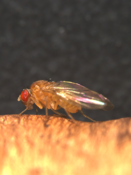Immigrans-tripunctata radiation Species group of the subgenus Drosophila
The immigrans-tripunctata radiation is a speciose lineage of Drosophila [ 1] [ 2] Drosophila .
Species groups
The following species groups and numbers largely derive from O'Grady (2018).[ 2]
Sequenced genomes or transcriptomes
The following species have extensive genetic sequence data available. [Last updated: 24 August 2019]
Quinaria species group
Immigrans species group
Testacea species group
Gallery
References
^ a b Hanson MA, Hamilton PT, Perlman SJ (October 2016). "Immune genes and divergent antimicrobial peptides in flies of the subgenus Drosophila" . BMC Evolutionary Biology . 16 (1): 228. doi :10.1186/s12862-016-0805-y PMC 5078906 PMID 27776480 . ^ a b c d e f g h i j o'Grady, Patrick M.; Desalle, Rob (2018). "Phylogeny of the Genus Drosophila" . Genetics . 209 (1): 1– 25. doi :10.1534/genetics.117.300583 . PMC 5937177 PMID 29716983 . ^ Peñafiel-Vinueza, Ana Danitza; Rafael, Violeta (2018). "Five new species of Drosophila guarani group from the Andes of southern Ecuador (Diptera, Drosophilidae)" . ZooKeys (781): 141– 163. doi :10.3897/zookeys.781.22841 PMC 6160839 PMID 30271239 . ^ "FlyBase phylogeny" . Retrieved 24 August 2019 .^ Koshikawa, Shigeyuki; Giorgianni, Matt W.; Vaccaro, Kathy; Kassner, Victoria A.; Yoder, John H.; Werner, Thomas; Carroll, Sean B. (2015). "Gain of cis-regulatory activities underlies novel domains of wingless gene expression in Drosophila" . Proceedings of the National Academy of Sciences . 112 (24): 7524– 9. Bibcode :2015PNAS..112.7524K . doi :10.1073/pnas.1509022112 PMC 4475944 PMID 26034272 . ^ a b c Hill, T.; Koseva, B. S.; Unckless, R. L. (2019). "genome of Drosophila innubila reveals lineage-specific patterns of selection in immune genes | Molecular Biology and Evolution | Oxford Academic" . Molecular Biology and Evolution . 36 (7): 1405– 1417. doi :10.1093/molbev/msz059 . PMC 6573480 PMID 30865231 . ^ Zhou, Qi; Zhu, Hong-mei; Huang, Quan-fei; Xuan, Zhao-lin; Zhang, Guo-jie; Zhao, Li; Ding, Yun; Roy, Scott; Vicoso, Beatriz; Ruan, Jue; Zhang, Yue; Zhao, Ruo-Ping; Mu, Bo; Min, Jiu-Meng; Zhang, Qing-hui; Li, Jian-wen; Luo, Yin-Ling; Liang, Zu-Heng; Ye, Chen; Li, Rui-Qiang; Zhang, Xiu-Qing; Wang, Jun; Wang, Wen; Bachtrog, Doris (2012). "Deciphering neo-sex and B chromosome evolution by the draft genome of Drosophila albomicans" . BMC Genomics . 13 : 109. doi :10.1186/1471-2164-13-109 PMC 3353239 PMID 22439699 . ^ Vicoso, Beatriz; Bachtrog, Doris (2015). "Numerous Transitions of Sex Chromosomes in Diptera" . PLOS Biology . 13 (4): e1002078. doi :10.1371/journal.pbio.1002078 PMC 4400102 PMID 25879221 . ^ Hamilton, P. T.; Leong, J. S.; Koop, B. F.; Perlman, S. J. (2014). "Transcriptional responses in a Drosophila defensive symbiosis - Hamilton - 2014 - Molecular Ecology" . Molecular Ecology . 23 (6): 1558– 70. doi :10.1111/mec.12603 . PMID 24274471 . S2CID 2964885 .




